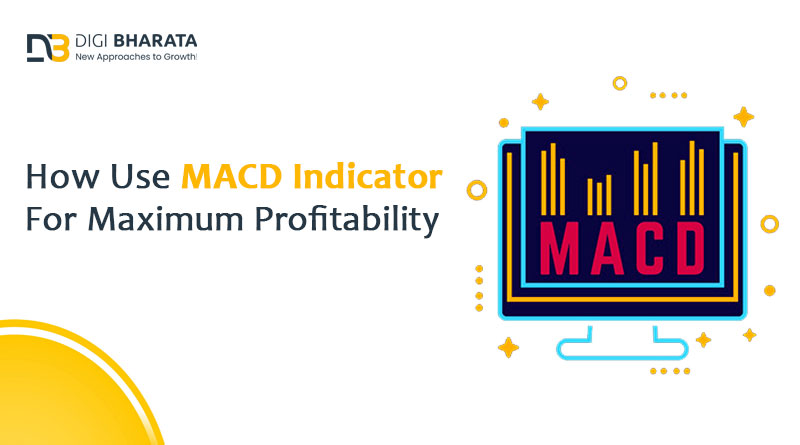The MACD indicator is one of the most popular indicators for technical analysis, which provides traders with an easy way to understand the power behind a price move. It shows traders when momentum is increasing and decreasing and helps them confirm breakouts from support or resistance levels.
This article will show you how to trade the MACD indicator using its default settings and explain other settings that can help you better identify these signals. Let’s get started!
Table of Contents
What Is The MACD Indicator?
The MACD stands for moving average convergence divergence, a measure of price momentum that uses two exponential moving averages (EMA). The first EMA represents the short-term trend, while the second EMA represents the long-term trend. The MACD is a leading indicator for the market, which means it moves before it does. A positive number indicates that the short EMA has moved higher than its longer-term counterpart, while a negative number shows that the short EMA has dropped below its long-term counterpart.
The default settings are 12 and 26 for both EMAs. When looking at the chart, values above zero indicate that momentum is increasing behind the price moves upward. In contrast, numbers below zero show that momentum is decreasing behind declines in price. Traders expect to see an uptrend continuing higher or a downtrend continuing lower. But if the MACD starts to move away from this setup, it means momentum is changing, and traders would expect price action to reflect that change.
If you’re looking for confirmation of a breakout, there’s also an exponential moving average (EMA) called Signal Line, which adds nine periods to the MACD line. This is added by default on most charting platforms and will help you confirm breakouts: when the MACD crosses its signal line, that tends to indicate a strong movement in the underlying market. It can also be used when prices are reversing, showing traders where potential entry points could be found (see more about using moving averages as support).
As with almost all technical indicators, periods (called parameters) can be adjusted to make the indicator more or less sensitive. For example, the default settings for MACD will tend to align well with longer-term trends in the market, which is why they’re generally set at 12 and 26. However, very short-term traders might want to adjust this to a shorter period to reflect their trading style. For example, a 10-period can work well if you use it on the hourly chart, while 5-minute charts might require a 12 or 14 momentum value to capture more of these smaller price movements.
In addition, many traders like to shift the MACD line and signal line up or down by adding an EMA of 9 above or below either line. If you do this, the MACD becomes a momentum oscillator instead of an indicator that detects momentum changes and breakouts. As such, traders can use it to confirm price tops and bottoms to pinpoint entry points or exit their positions when looking to scalp trading setups (see our article on scalping strategies for more information).
The flexibility of how to trade MACD is one of its strongest features, as there are several ways to interpret what it does, depending on your trading style and technical analysis approach. For example, many traders find that the default settings work well with longer time frames, while shorter-term traders often adjust the period to reflect their chosen timeframe better.
There are also other settings that many traders use with slightly different interpretations (see the article below for more information):
– Fast Line: The three-period EMA of the MACD value is called the short line. This tends to be less sensitive and can be used as support or resistance when trading long-term trades.
– Slow Line: Expanding on this, a nine-period EMA of the short line (called slow line) is created by default and acts as a continuation tool. It forms part of many traders’ buy/sell signal strategies based on divergence.
– Signal Line: Finally, the MACD signal line is simply a nine-period EMA of the signal line. Traders will often use it for sell/buy signals and divergence.
In addition to these three lines, there are also several other ways in which traders can interpret what the MACD does or use it to gauge expected market moves; below, we discuss two popular methods and look at how they can help dictate your trading decisions:
Analysis Using Moving Averages
A long-term time frame such as a weekly chart is good for identifying key support levels that should offer strong resistance and vice versa. However, daily charts are more useful if you’re looking for trade setups during the week. The MACD and EMA lines can help create a trend channel you can trade, allowing you to mark areas of support and resistance.
Divergence
Finding divergence levels that point towards the next expected move is one of the most popular uses of this indicator. Traders look for divergences between price and MACD or momentum (aka short line) to gauge when market conditions may change. MACD peaks or bottoms that don’t reach highs or lows made by price action are seen as an indication that traders may have already reached their high/low; in other words, they are overbought/oversold:
When using MACD with divergence, traders generally look for bearish breakouts from these divergences and buy into bearish momentum. Using these types of forex trading strategies, traders can limit sell orders just below the low made by price action and stop buy orders slightly above the high; this is what we mean by buying or selling into a trend.
MACD Strategy Key Takeaways
1. The MACD is an oscillator that can identify momentum or trend direction changes or even as a simple entry/exit signal.
2. To trade the MACD, traders should look for crossovers of its five and 12-period moving averages or divergence between the indicator line and price action.
3. To minimize risk when trading the MACD, traders should set stop-losses on their positions below chart support levels. Similarly, take-profits could be set at resistance levels above chart peaks.
4. Traders should also weigh the reliability of a MACD crossover or divergence signal with other technical tools such as c, candlestick patterns, and volume indicators to confirm trend directions.
5. Short-term traders may also use shorter timeframe charts for better position entry points. Conversely, longer-term investors can stick to longer timeframes before entering trades off momentum crossovers in the MACD indicator.
6. Finally, traders who apply the MACD strategy should ensure that they are comfortable with the risks before they deploy capital on any trade based on this indicator’s signals.
Trading Divergence
One of the most powerful ways to use the MACD indicator is to look for trading divergence. Trading divergence occurs when the price makes a new high or low, but the MACD fails to make a corresponding high or low. This can indicate that an asset is overbought or oversold and may be poised for a reversal.
There are several different methods you can use to trade divergence. One approach is to wait until the price makes a new high or low, then place a buy or sell order once the price crosses above or below the MACD line. Another strategy is to watch for bullish or bearish momentum divergences, which indicate that buying or selling pressure may weaken, suggesting that a reversal could be on the horizon.
Regardless of your trading strategy, it’s important to understand that divergence is just one tool in your trading arsenal. To be successful, you’ll need to combine other technical indicators with MACD and have a solid understanding of risk management principles. With these tools and skills, you can become a profitable trader using the MACD indicator for maximum profitability.
Bottom Line
In conclusion, the MACD indicator is a versatile and valuable tool for technical traders of all styles. But, like any indicator or signal, there’s no need to use it. Instead, when you include it in your trading strategy, ensure you understand the indicators well enough to see when momentum is building and swirling inside an asset. You’ll also want to keep other tools like candlestick patterns at hand so that you can use them as confirmations (or not) of what the MACD is saying.
Finally, always remember that risk management should be something you take into consideration before opening a trade based on this indicator’s signals; however, with mixed results from numerous studies using the MACD indicator in forex markets across dozens of countries, it remains a tool that has the potential to be quite profitable when used appropriately.





















+ There are no comments
Add yours